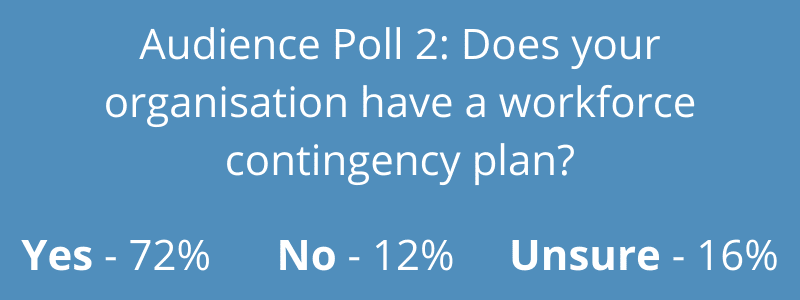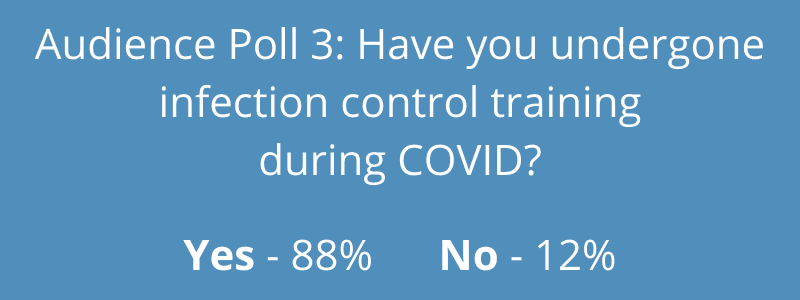Sector Support Webinar: What can Home and Community Care Providers learn from the Impacts of COVID in Residential Care?
The COVID-19 pandemic has taught us all to be reflective of our policies and practices and in some cases, re-evaluate the way we deliver services all together. It is important to continue to learn as the pandemic progresses so we can keep clients and staff safe and well.
This 80 minute webinar explores some of the topics that have emerged from COVID outbreaks in residential care in both NSW and Victoria and how home and community care providers can transfer these learnings into their own organisational context. Below our expert panellists provide advice for aged care providers to be proactive, not reactive, amidst the pandemic and offer practical information about management, staffing, infection control and communication during COVID-19.
Download our tip sheet for home and community care providers here
Webinar Summary
Below is a wrap up summary from the Q&A panel hosted by Ilsa Bird, Sector Support Coordinator.
Key Causes of Outbreaks in Residential Care
Q1. In your view, what were the key causes of the outbreaks in residential care?
Michael Hall and Therese Adami
- Poor infection control
- Inadequate/poor use of PPE – due to inadequately trained staff
- Lack of social distancing
- Practice of putting infected patients in same room
- Infection came into premises from outside visitors
Recommendations for Management

Q2. An outbreak is defined as one case. Relative to management and operations, what should an organisation’s first response be if a case is linked to their organisation, staff or clients?
Therese Adami
- Be open & listen to both staff & clients
- Get the facts around caring for each client so that you know how you can best assist them. Understand the risks associated with whatever each client has been doing in the past 14 days. They have a 27-question tool that they use.
- Monitor & nurture clients – what else can you do for them to help them stay at home?
- Look at ongoing care of staff – make sure they are supported & trained
- Check the client is receiving appropriate medical care & has received medical clearance
- Understand staff perspective – they keep register that contains 17 data points
Q3. It is recommended that organisation have an outbreak management plan. What are some key components that must be included in this plan?
Michael Hall
- Appoint a pandemic coordinator to ensure that you are able to get in contact with everyone involved in a clients care
- Communication – constant with staff & clients
- Have client key contacts in place – GP, family etc
- Have key organisational contacts in place – Dept Health/Funders/Government Bodies/Other local organisations etc
- Rostering – know how to manoeuvre rosters
- Have Post Outbreak Support Plan in place
- Your Outbreak Plan should be part of your Pandemic Plan
Q4. An outbreak management plan does not operate in isolation from the rest of the organisation, so what are some of the other operational procedures that may need to be adapted or updated when creating an outbreak management plan?
Therese Adami
- Communication – regular meetings & updates with staff/board/clients/dept etc
- Staff training – ensure that they have all undertaken online Government training on PPE, infection control, how to screen clients before entering their home
- Incident reporting tool – ensure relevant & up-to-date
- Workforce contingency plans if staff need to self isolate
- Supply management – make sure suppliers are adhering to Government regulations
- Screening of clients – creation of Tool for staff
- Risk assessment for group activities at wellness centres
- Procurement – monitor use of equipment & ensure adequate stock levels
- Utilise Government Factsheet “It’s Ok to Have Homecare” to alleviate client concerns
- Use of online activities & video messages to reassure clients
- Be aware of subsidy changes & communicate these to clients
Staffing

Q5. In aged care we have a highly casualised workforce which can be challenging when organisations are short staffed. What are your recommendations for workforce planning and emergency staffing during COVID?
Michael Hall
- Know your workforce – undertake staff survey to determine gaps in knowledge you have about your staff
- Need larger workforce including a reserve of staff that you can access to assist in emergencies
Q6. Often care workers work with more than one organisation and, across home and community care and in residential care. What should organisations put in place to reduce the risk of transmission if a staff member is linked to an outbreak in another organisation?
Therese Adami
- Be a good employer so that staff want to work with you and remain with you
- Promote principle of good self management to reduce & prevent contraction & spreading of virus
- Consider staff payment measures if staff are required to self isolate due to being in contact with a positive client
Infection Control


Q7. Infection control is one of the most important keys to stopping the transmission of COVID. What are the some of the most commons gaps in infection control that may put clients and staff at risk?
Michael Hall
- Correct use & availability of PPE – keep minimum of 3 months stock of equipment
- Ensure that infection control policies & procedures have no room for interpretation – you can’t have grey areas in relation to CV-19
- Have clear lines of escalation & have personnel available to deal with situation
Q8. Earlier this year, The NSW Government found cross-infection in residential facilities due to the incorrect use of PPE by staff who weren’t correctly trained. What are some of the most common misconceptions about PPE and infection control training?
Therese Adami
- I’m not going to contract COVID-19
- I’ve done the training so don’t need to be reminded – important to reinforce correct hand washing practice
- Understanding masks – how to use, correct disposal, types that are effective e.g. cloth masks are not deemed effective in infection control
Q9. It’s all well and good having a quality infection prevention and control programs on paper, but how can organisations embed infection control practices into organisational culture?
Michael Hall
- Have consistent and clear communication – repeat messages minim of 4 times
- Find new ways of getting messages out to staff – use different platforms & methods e.g. Microsoft Teams
Effective communications


Q10. Communication is essential to reassure staff and clients during COVID and even more importantly if a case is linked to an organisation. What is the most important information that needs to be communicated to a) staff and b) clients
Therese Adami
- Two way communication critical and using different mediums
- Download and use of Government Apps – all staff provided with work mobiles
- Government communication tools & factsheets
- Reinforce Government messages
- Staff training – reinforcing and checking practices are followed
- Communication around COVID – prevention & what to do if diagnosed
Q.11 Communication should also be two-way, what information is important for clients and staff to disclose to the organisation?
Michael Hall
- Look at your referral process – do you need to change this to ensure you are getting important information
- Make sure that you have adequate client contact – family members, GP, other health professionals
- Ensure clients inform you if they are unwell or have been in contact with others who have tested positive for CV, if they have been in hot spots etc
- Need immediate feedback if staff are not following protocols & procedures
Audience Q & A
Using Volunteers
- Screening tool used for both clients & volunteers
- Ensure both parties are wearing masks & maintain social distancing in face-to-face activities
- Utilise aged volunteers for online activities and not face to face
- Be aware that insurance may not cover volunteers if they contract cv-19 via their volunteer work
- Apply same protocols used for casual staff for volunteers
Strategies to engage clients in infection control
- Communicate with clients via a number of mediums including hard copy
- Staff also receive copy of what was sent to clients
- Undertake both client & staff surveys
Utilising Subcontractors
- Undertake random audits and obtain client feedback to ensure that sub contractors are adhering to government regulations and appropriate use of PPE
Online Workforce Platforms
- Ensure that you know how your clinical governance applies to the use of staff from online platforms
- Ensure that you have appropriate measures in place as these can pose a much higher risk
Webinar concluding statements
Q12. To summarise our discussion today, what are the top 5 things that a community care provider can do right now to avoid an outbreak?
Michael Hall
- Communicate – use multiple channel & be consistent in your message
- Test staff & clients at first signs of symptoms
- Establish CV-19 strong protocols & escalation procedures
- Have no grey areas in protocols
- Have adequate & appropriate PPE
Therese Adami
- Communicate constantly
- Utilise screening tools
- Ensure CV-19 protocols & that you have training in place to support these
- Staff engagement practices & have workforce contingencies in pace
- Establish a client & staff register
About Our Panellists
Therese Adami is the General Manager for Community Care at Catholic Healthcare. Therese is responsible for strategic and business outcomes, leading teams to achieve strong sales growth, excellent service and high levels of engagement across the country.
Michael Hall is the CEO of Regal Home Health. Michael Hall has many years of senior experience across a diverse range of industries and has operated in the business to business and business to consumer environments.
If you would like to receive information about future webinars as well as the latest aged care updates, subscribe to our monthly e-bulletin here.
Contact us: sectorsupport@yourside.org.au